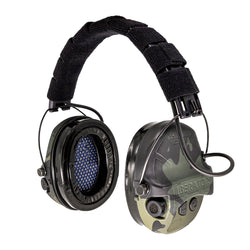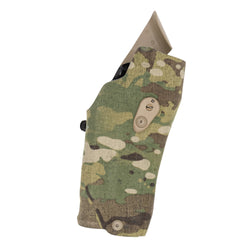The Cold War is defined as a period of geopolitical tensions between the Soviet Union and the Eastern Bloc, and the United States and the Western Bloc. It lasted from 1947 to 1991 and was an era of rapid innovation in weapons. However, for this piece, we’ll stick to discussing small arms development—digging into missiles, aircraft, tanks, and more would take up an entire book.

The term Cold War implies that no shots were fired, which is only true if you focus solely on the Eastern and Western Blocs not trading shots. Proxy wars in Vietnam, Afghanistan, Cuba, and more made the Cold War anything but cold. These conflicts—and the broader geopolitical tension—had a profound influence on firearms design, sparking an incredibly innovative era for firearms development.
To this day, we still feel the impact of those innovations.
The Big Influences on Cold War Weapons Development
Two major forces shaped the evolution of firearms during this period. While there were certainly more influences at play, these two stand out due to their wide-reaching effects on nearly every nation involved in World War II:
- A post-World War II world, and
- The formation of massive global alliances.
Lessons Learned From World War 2
It’s mind-boggling how big World War II was. It was a conflict with so many fronts, so many belligerents, and so many battles: from jungles to cities, the deserts in Africa to the tundra of Eastern Europe, and the open sea to the skies. The experience gained during this war deeply shaped how nations approached small arms design going forward.

Global Alliances
World War II saw ad-hoc Global Alliances formed out of necessity. The alliances were a bit messy, and the logistics between allied armies were often disastrous. After the war, countries deliberately formed global alliances in an attempt to usher in a new era of peace. NATO and the Warsaw Pact weren’t just about political alignment—they were also about planning, logistics, and cooperation. Lessons learned about coordination and standardization during the war heavily influenced post-war small arms development.
The Cold War’s Effect On Small Arms
Now that we’ve established the greater overall influences, let’s look at the Cold War’s specific effects on firearms innovation.
Standardization
Standardization became a core goal in small arms design because it streamlines logistics. Prior to the start of the Cold War, it wasn’t uncommon for different military branches in the same country to use different small arms. Throughout the Cold War, standardization became the goal. Tactics win battles, but logistics win wars.

The Western Bloc formed NATO, and international standardization became important. NATO would first adopt the 7.62 NATO cartridge, and there was a plan to adopt the FN FAL, but that fell apart. It’s worth mentioning that the FAL did become a mainstay of NATO forces, but the US went with the M14, and the Germans went with the G3.

In the Eastern Bloc, the Soviet SKS and AKM weapons slowly leaked out into the Warsaw Pact countries. Eventually, the AK became the number one weapon amongst second-world countries. The AKM, the RPK, PKM, and more armed Eastern Bloc and communist Asian countries.
Eventually, both blocs transitioned to intermediate cartridges—5.56mm for NATO and 5.45mm for the Warsaw Pact. NATO even standardized the M16 magazine, which became the STANAG. This standardization would define the Cold War era of small arms design and become a major factor when countries shopped for a weapon system.

In World War II, the logistics lesson was a nightmare. During the Cold War, that lesson took hold—standardization took root and continues to guide military procurement today. Gone were the days of having to account for dozens of different calibers. Instead, forces reduced and standardized on a specific set. This shift occurred in both the Western and Eastern Bloc, and it remains a key consideration today.
Do It All Weapons
During WWII, a single infantry squad might carry four to a half dozen firearm platforms. Conservatively, we had the M1 Garand, the BAR, the Thompson or M3, and the M1 Carbine. This doesn’t account for specialist weapons like bazookas, machine guns, and sniper rifles. Different firearms require different parts, different magazines, ammo, and training. It’s another logistical nightmare. This was the same the world over.

This led to attempts to create weapons that could do all of these jobs. Rifles like the M14, FAL, G3, and AK were intended to combine the features of the infantry rifle, the automatic rifle, the submachine gun, and the carbine to create a weapon that could do it all. These “do-it-all” guns would simplify squad logistics immensely and help create a standardized form of training that took less time and, therefore, less money.
The success of this concept is debatable, especially in the era of 7.62 rifles. However, it’s notable that the Cold War do-it-all weapon mindset persists to this day.
Assault Rifles
An assault rifle is defined as a lightweight rifle that fires an intermediate cartridge from a detachable magazine with select fire capability: more or less the perfect combination of automatic rifles, infantry rifles, submachine guns, and carbines.
While they fit the do-it-all weapon concept, they get their own section because they are one of the most important Cold War firearm innovations. Assault rifles first appeared during World War II in the late war production STG 44.

The Soviets adopted the assault rifle first, fielding the AK-47 and later the AKM. They were almost two decades ahead of NATO. Eventually, the United States adopted the M16, and NATO followed with various rifles. The Western World adopted the 5.56 NATO cartridge, and a plethora of rifles like the AUG and the G36 occupied the military arsenals of the Western World.
Modern Handguns
At the end of World War II, many countries were still using revolvers or a mix of various handguns. Much like with rifles, military forces began standardizing their sidearms. Over the course of the Cold War, most militaries phased out revolvers in favor of automatic handguns.

Handguns play an extremely small role in warfare, so there wasn’t a huge move to standardize them internationally. NATO chose the 9mm cartridge, but countries like the United States didn’t move to 9mm until the end of the Cold War.
General Purpose Machine Guns
The Germans contributed the first assault rifle and arguably designed the first general-purpose machine gun with the MG-34. Prior to the Second World War, the belt-fed machine gun was a big, hefty thing designed for static locations. Throughout the war, attempts were made to make these ancient machine guns more portable, but none achieved the success of the MG-34/42 series.

During the Cold War, most nations saw the benefits of a full-powered machine gun that could serve in various roles. These medium machine guns fired full-powered rifle rounds and were air-cooled, belt-fed guns. These guns would serve with the infantry and be fitted to trucks, helicopters, on the sides of ships, and more.

GPMGs would be light enough to carry on foot but capable enough to occupy defensive positions. To this day, the GPMG rules the machine gun market.
The End of the Cold War
After the Cold War ended in 1991, the lessons learned remained pertinent. Weapon designs evolved, but there wasn’t a huge change for decades. The United States still uses variants of the M-16, and the Russian Federation is still using AK-pattern platforms. The assault rifle is still the main firearm of most military forces.
Recent warfare—especially asymmetric conflicts—has further refined what was learned during WWII and the Cold War.

Only recently have we seen something relatively new. The United States Army and the Next Generation Squad Weapon concept seem to be a step back to battle rifles and a rejection of assault rifles. It’s worth mentioning that the program is still new and hasn’t even gotten close to arming a significant number of soldiers.
The Cold War ended in 1991, but its influence is still felt today. Outside of the NGSW, there haven’t been any concentrated efforts to make radical changes to firearms technology. Outside of the invention of cartridge-based firearms, it might have been the most influential era in firearms development.











